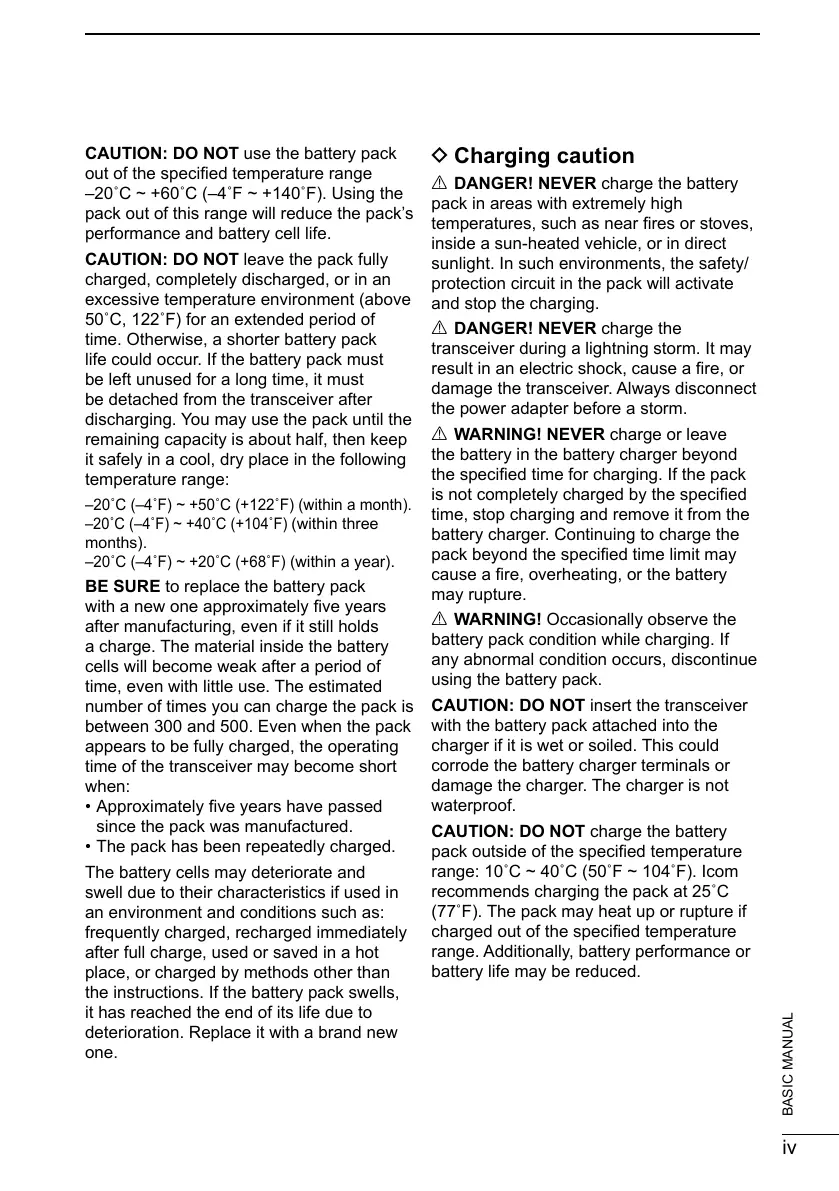iv
1
7
4
10
15
18
2
8
13
5
11
16
3
9
14
6
12
17
BASIC MANUAL
CAUTION: DO NOT use the battery pack
out of the specied temperature range
–20˚C ~ +60˚C (–4˚F ~ +140˚F). Using the
pack out of this range will reduce the pack’s
performance and battery cell life.
CAUTION: DO NOT leave the pack fully
charged, completely discharged, or in an
excessive temperature environment (above
50˚C, 122˚F) for an extended period of
time. Otherwise, a shorter battery pack
life could occur. If the battery pack must
be left unused for a long time, it must
be detached from the transceiver after
discharging. You may use the pack until the
remaining capacity is about half, then keep
it safely in a cool, dry place in the following
temperature range:
–20˚C (–4˚F) ~ +50˚C (+122˚F)
(within a month).
–20˚C (–4˚F) ~ +40˚C (+104˚F)
(within three
months).
–20˚C (–4˚F) ~ +20˚C (+68˚F)
(within a year).
BE SURE to replace the battery pack
with a new one approximately ve years
after manufacturing, even if it still holds
a charge. The material inside the battery
cells will become weak after a period of
time, even with little use. The estimated
number of times you can charge the pack is
between 300 and 500. Even when the pack
appears to be fully charged, the operating
time of the transceiver may become short
when:
• Approximately ve years have passed
since the pack was manufactured.
• The pack has been repeatedly charged.
The battery cells may deteriorate and
swell due to their characteristics if used in
an environment and conditions such as:
frequently charged, recharged immediately
after full charge, used or saved in a hot
place, or charged by methods other than
the instructions. If the battery pack swells,
it has reached the end of its life due to
deterioration. Replace it with a brand new
one.
D Charging caution
R DANGER! NEVER charge the battery
pack in areas with extremely high
temperatures, such as near res or stoves,
inside a sun-heated vehicle, or in direct
sunlight. In such environments, the safety/
protection circuit in the pack will activate
and stop the charging.
R DANGER! NEVER charge the
transceiver during a lightning storm. It may
result in an electric shock, cause a re, or
damage the transceiver. Always disconnect
the power adapter before a storm.
R WARNING! NEVER charge or leave
the battery in the battery charger beyond
the specied time for charging. If the pack
is not completely charged by the specied
time, stop charging and remove it from the
battery charger. Continuing to charge the
pack beyond the specied time limit may
cause a re, overheating, or the battery
may rupture.
R WARNING! Occasionally observe the
battery pack condition while charging. If
any abnormal condition occurs, discontinue
using the battery pack.
CAUTION: DO NOT insert the transceiver
with the battery pack attached into the
charger if it is wet or soiled. This could
corrode the battery charger terminals or
damage the charger. The charger is not
waterproof.
CAUTION: DO NOT charge the battery
pack outside of the specied temperature
range: 10˚C ~ 40˚C (50˚F ~ 104˚F). Icom
recommends charging the pack at 25˚C
(77˚F). The pack may heat up or rupture if
charged out of the specied temperature
range. Additionally, battery performance or
battery life may be reduced.
